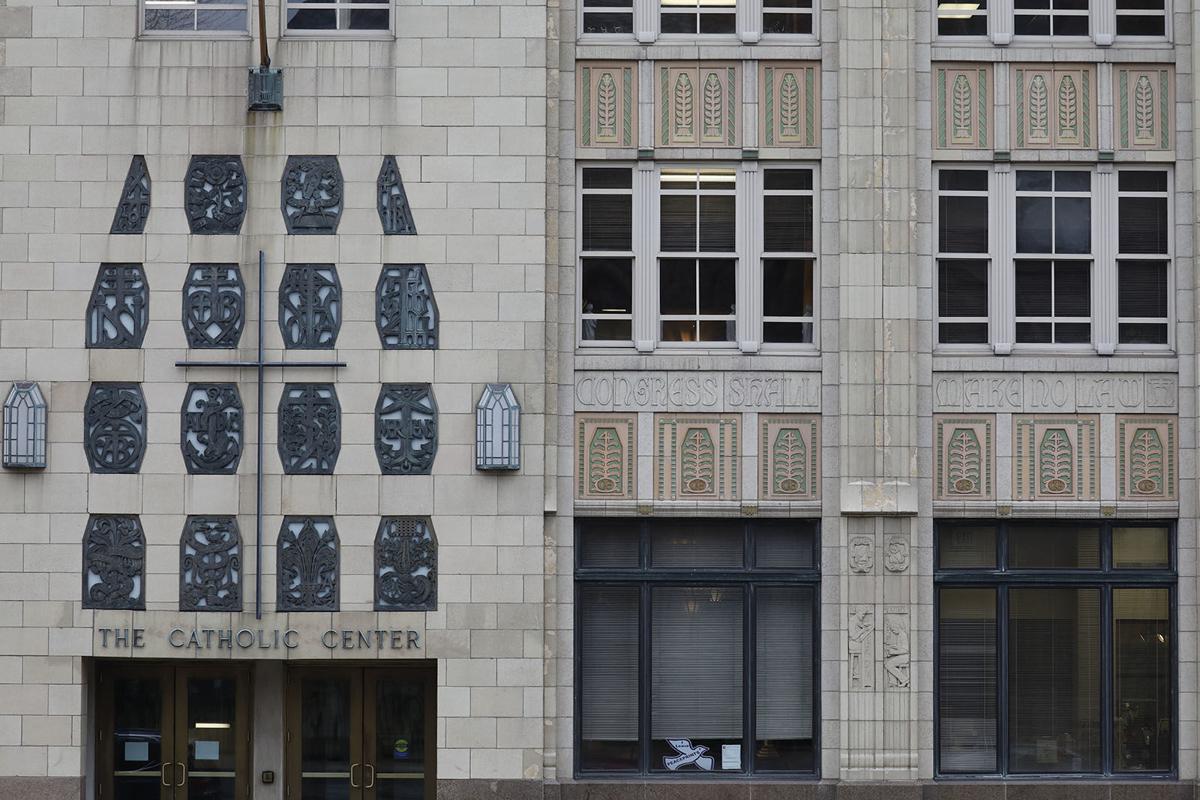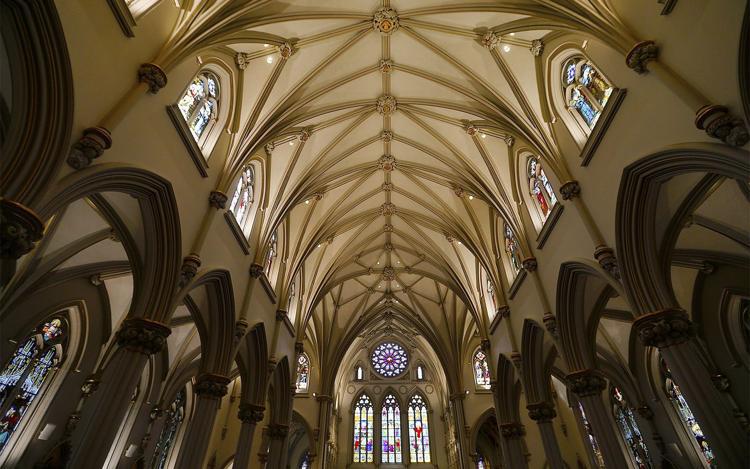|
School sale gives glimpse into value, breadth of Buffalo Diocese property
By Jay Tokasz
Buffalo News
July 13, 2020
https://buffalonews.com/news/local/school-sale-gives-glimpse-into-value-breadth-of-buffalo-diocese-property/article_464ed17e-c2ee-11ea-a849-ff90d655f8e0.html
 |
The headquarters of the Catholic Diocese of Buffalo on Main Street is the diocese’s most valuable property, appraised at $9 million, according to court papers.
Photo by Derek Gee |
 |
St Joseph's Cathedral in Buffalo is among the properties that potentially could be sold to pay off settlements in Child Victims Act lawsuits.
Photo by Mark Mulville |
The operators of Archbishop Walsh High School in Olean thought they had a deal last December with the Buffalo Diocese to pay $150,000 for the building where the high school has been located since 1959.
But a committee that represents survivors of childhood sex abuse is saying not so fast.
The deal that would have transferred title for the two-story, 55,000-square-foot on North 24th Street to the high school’s foundation immediately was put on hold when the diocese filed for Chapter 11 bankruptcy on Feb. 28.
The diocese’s lawyers have since asked Chief Judge Carl L. Bucki of the U.S. Bankruptcy Court in the Western District of New York to allow the sale to go through so that the diocese can use the proceeds toward settling more than 250 Child Victims Act lawsuits. In response, lawyers for the official committee of unsecured creditors, which represents abuse victims, have objected to the deal, arguing in court papers that the sale price is too low, and the diocese failed to seek out other potential buyers who might spend more for the property.
The pending sale of an old school building that had been leased by the diocese to Walsh for $1 per year since 1992 may seem insignificant in the scope of a bankruptcy that involves tens of millions of dollars. But the current court squabble highlights the more than three dozen properties the creditors committee will be eyeing as sources of settlement cash. Collectively, the properties are worth at least $16 million, and possibly much more, because most of the properties haven’t been recently appraised, according to federal court papers.
In addition to the Archbishop Walsh campus, the diocese owns the buildings and grounds of Cardinal O’Hara High School in the Town of Tonawanda, St. Mary’s High School in Lancaster, Bishop Timon-St. Jude High School in Buffalo, Notre Dame High School in Batavia and DeSales Catholic in Lockport.
Other properties potentially in play to be sold as part of a settlement include vacant parcels in Hamburg, Grand Island and Dayton; various city parking lots and garages; three priest retirement homes; the Catholic Center on Main Street; Christ the King Seminary in Aurora; and St. Joseph Cathedral on Franklin Street.
The school buildings are an example of how complicated the Buffalo Diocese’s operations and finances are. The diocese ran the high schools for many years until the early 1990s, when each of the schools became independent entities, run by their own school boards and with separate charters from the state Board of Regents. The diocese held onto the buildings and agreed to lease them for $1 per year to the independent schools, which were expected to set their own policies and tuition rates, develop curricula and maintain the buildings. The diocese continued to provide an annual subsidy to the high schools that was at one point more than $2 million overall but shrunk in 2019 to less than $500,000.
Other area Catholic high schools, including Nardin Academy, Canisius and Mount Mercy in Buffalo; Sacred Heart in Amherst; St. Joseph’s Collegiate Institute in the Town of Tonawanda; Mount St. Mary Academy in Kenmore and St. Francis in Athol Springs, were founded and run by non-diocese entities and do not have buildings owned by the diocese.
The diocese’s lawyers said selling the Archbishop Walsh building to the school’s foundation was “the best and only opportunity to realize value from the property” because it needs an expensive new roof and because the high school’s $1 per-year lease runs through 2041.
Thomas J. Manko, Archbishop Walsh president and principal, said in an email response to The News that the decision to buy the building and grounds was unrelated to the diocese’s bankruptcy. School officials first approached the diocese about it in January 2019, more than a year before the bankruptcy filing, he said.
“We felt that it would be easier to approach benefactors for major contributions if the school was owned by a Walsh affiliated institution instead of the Diocese of Buffalo. The purchase itself will be funded through donations from such benefactors,” said Manko. “We feel that our foundation purchasing the school and the school controlling its own destiny is in the long-term best interest of Archbishop Walsh, its students, staff and faculty.”
Manko also said the negotiated price of $150,000 was a “fair deal” and “reflects what the market will bear.”
But a lawyer for the creditors committee called the deal “fraught with the badges of fraud” and urged Bucki to nix it.
The diocese’s primary obligation in bankruptcy is to maximize the value of its estate for creditors and that it had failed to do so by undervaluing the property with an “as is” appraisal, said attorney Ilan D. Scharf.
“The sale has not been negotiated in good faith. It is an insider transaction at a price that is in all likelihood depressed based on the actions of the high school and because it relies on an appraisal designed to obtain a lower value,” Scharf said. “The diocese is clearly more concerned about the high school’s ability to continue using the property than with maximizing value for the benefit of creditors.”
Bucki is expected to hear arguments Wednesday on the proposed sale.
What happens with the Walsh buildings raises questions about the future of all the former diocese-sponsored high schools. None of the schools is flush with cash and most have struggled over the years to maintain enrollments, as the population of school-age children in Western New York has continued to slide downwards. Multiple calls to the principals or presidents of Timon, O’Hara, St. Mary’s and Notre Dame were not returned.
In court papers, the diocese listed appraised values of $315,000 for the Walsh property and $1.5 million for the Timon property in South Buffalo. It didn’t list values for the O’Hara, St. Mary’s and Notre Dame properties. Nor did it include a value for the DeSales building, which formerly housed a high school and now is home to a regional Catholic elementary school.
The diocese’s most valuable appraised property, according to court papers, is the Catholic Center, its main administrative building at 795 Main St., the former home of the Courier-Express newspaper. The diocese said the property, located in the city’s booming medical corridor, was appraised at $9 million. The diocese said most of the properties haven’t been appraised, but it did list book values for some of the properties, including $3.6 million for its three priest retirement homes and $2 million for a Newman Center near the University at Buffalo in Amherst.
In at least two completed bankruptcy reorganizations, diocese-owned school properties were sold to raise cash toward a global settlement fund for abuse victims, and the schools continued to operate.
Three high schools in the Archdiocese of St. Paul & Minneapolis agreed to buy property they had been leasing from the archdiocese for years, contributing $4 million towards a $210 million settlement with abuse survivors.
In the Diocese of Fairbanks, Alaska, an endowment known as the DONATE Fund that had been established in 1980 to support future parish, school and diocese needs paid the diocese $3.5 million for several Catholic school properties, $1.2 million for the chancery, and $1.1 million for a priest residence. Proceeds of the sales helped the diocese contribute nearly $8 million in cash toward a settlement.
Contact: JTokasz@buffnews.com
|

